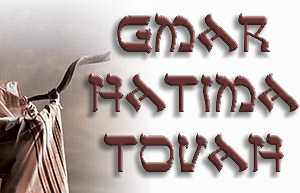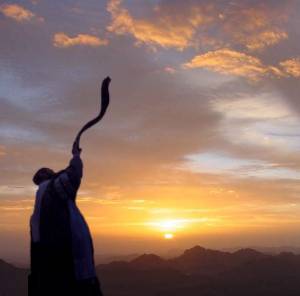
|
The Fall Festivals Of Israel
Yom Kippur
The Day of Atonement
by haRold Smith
based in Jerusalem, Israel
Today, the streets are quiet as the entire country of Israel has shut down for the holiest day of the year, Yom Kippur. Jewish people everywhere have been greeting each other with the phrase - "May You Be Sealed for a Good Life".
"On the tenth day of this seventh month is the Day of Atonement; it shall be a holy gathering for you, and you shall afflict yourselves and present an offering by fire to YaHoVeH. And you shall do no work on this day, for it is a day of atonement for you before YHVH your Elohiem." (Leviticus 23:27-28).
Starting at sundown the previous evening and continuing until the first three stars can be seen in the next evening sky, Jews all over the world will begin a 25 hour complete fast - no food, no water - and spend the day in prayer and reflection. There is no driving, public transport is suspended and even the roads are completely closed. There are no phone calls. Places of entertainment are closed - there are no television and radio broadcasts (not even the news), The police and IDF are on high alert as they always are at holiday times . Its solemnity is reinforced by memories of the surprise attack launched by Egypt and Syria agains Israel on Yom Kippur, 1973.
The days from Rosh Hashana to Yom Kippur are called the 10 days of penance, when through good deeds, prayer and repentance, we can soften a fateful life. The major precepts of Yom Kippur (lengthy devotional services and the fast) are observed even by much of the otherwise secular population. The level of public solemnity on Yom Kippur surpasses that of any other festival, including Rosh Hashana. The pre-fast meal is eaten in the early evening and should end one hour before sundown. After a day of prayer and introspection, the end of the fast is marked with the blowing of the shofar at the Neila (closing) prayer service in the synagogue.

|
|
'Kippur' Creator: David barPesah, Scribe Created: 14th Century |
Yom Kippur is considered the holiest of the Jewish holy days. When the temple was still standing, the Kohen Gadol, or high priest, would leave home seven days before Yom Kippur to live in the temple chamber. There he would practice the Yom Kippur ritual, in order to be sure he had it down perfectly. It was complex: first he had to remove his ordinary priestly robes and take a ritual bath in a place set aside for that purpose. Then he would put on special white clothes. After offering the ordinary morning sacrifice, he would offer a young bullock to atone for his own sins, (since he can't intercede for the people until he has been made clean himself); then, using coals from the altar, he would carry incense into the Dvir (Holy of Holies.) Then he would return to the altar for blood from the sacrifice, which he would sprinkle on the mercy seat (i.e., the lid of the ark of the testimony, see the Testimony for an expanded explanation). and seven times on the ground in front the ark. After this he would sacrifice a goat for the sins of the people, and sprinkle its blood on the ark and in front of it, as he had done with the blood of the bullock. This made atonement for the Holy of Holies. Next was to atone for the tabernacle, which he did by sprinkling the blood of both animals on the horns of the altar once, and seven times on the ground around it. Finally, he would expiate the altar of burnt offering by putting the blood on the horns and sprinkling it seven times on the ground. In this way the tabernacle -- and, in later times, the temple -- was atoned for.
The Azazel - After this, the high priest would go out into the court of the tabernacle (or temple) and lay his hands over the head of the scapegoat, confessing over it the sins of the people. Then the goat would be taken outside the camp (or in later times, the city) and be let go. This symbolized the removal of the sins from the people. According to the Talmud, a scarlet cord was tied around the neck of the scapegoat. This cord was reported to have turned white as the goat was led away from city. Following this, the priest would go back into the tabernacle to change out of the special white clothes to put on his usual priestly attire. The offerings were then completed by burning the fat on the altar, and the remains were burned outside the camp. The feast offering was next in line, and included a goat, a bullock, a ram, several lambs and corresponding meat and drink offerings, followed by the ordinary evening sacrifice.
A Break in the Pattern - How is atonement to be achieved now that the Temple is destroyed? Before the First Churban (destruction of the Temple in Jerusalem), prophets were sent to warn the people of the coming destruction, to call them to repentance, and to promise that a remnant would survive to inherit the promises of haBrit (Hebrew for "pact" or "covenant", see the Word). What prophet came before the Second Churban? There was one called Yohanan ha-Matbil (John the Baptiser), who testified of one called Yeshua. He called Yeshua "the Lamb of YHVH who takes away the sin of the world" (John 1:29, see the Kinsman Redeemer) thereby identifying Him as the ultimate Atonement. Yeshua himself predicted the Churban. If the claims of Yohanan and Yeshua are true, then YHVH's commitment to Israel remains unbroken, because he has not left his people perplexed. Otherwise, what can we say? Did YHVH forget about Israel and allow the Temple to be destroyed without warning and with no instruction what to do without it?
 The Babylonian Talmud records that for the last forty years before the Second Churban, the red cord around the neck of the scapegoat failed to change color. The temple was destroyed in 70 A.D. Forty years before that would have been just about the time Messiah Yeshua offered the ultimate sacrifice. This could explain why YHVH was no longer interested in scapegoats. Those who appropriate the atonement of Yeshua haMashiach (the Messiah) will be forgiven and inscribed in the book of LIFE, not for a year only but for perpetuity!
The Babylonian Talmud records that for the last forty years before the Second Churban, the red cord around the neck of the scapegoat failed to change color. The temple was destroyed in 70 A.D. Forty years before that would have been just about the time Messiah Yeshua offered the ultimate sacrifice. This could explain why YHVH was no longer interested in scapegoats. Those who appropriate the atonement of Yeshua haMashiach (the Messiah) will be forgiven and inscribed in the book of LIFE, not for a year only but for perpetuity!
We who believe in Yeshua as Messiah can easy see his ministry reflected in the temple service. The priest begins his day with a special bath, or mikveh, immersing himself in water, just as Yeshua began his ministry being immersed by John the Baptiser, or in a larger sense, by being born into human flesh ("born of water" -- John 3:5). The priest laid aside his usual ornate priestly garb for simple white attire. Yeshua "made himself of no reputation," (Philippians 2:7) but laid aside His divinity to accomplish his earthly mission of expiating the sin of the family of YHVH - Israel (see Establishing the Signet). The white kittel speaks of sinless purity, as He was pure and without sin. It is also reminiscent of the burial shroud. The high priest made a special sacrifice for his own sin (Leviticus 16:11), in order to be seen by YHVH as a sinless mediator, as Yeshua was sinless by his own virtue. Sprinkling the blood upon the Kapporeth (i.e., the cover of the Ark of the Testimony, which served as a sort of earthly throne for the Almighty) seems to represent presentation of the sacrifice to YHVH, the Father. Sprinkling the blood in front of the ark may indicate the opening of a way of approach to the Father. (The Ark was ordinarily unapproachable. The people in general were never allowed to enter the Holy of Holies, where the ark was. Even the high priest was allowed to enter only on Yom Kippur) The sacrifice "covered" (Kippur comes from the root word kaphar, which literally means "covering") the sins of the people and made YHVH approachable to sinful man (see the Law of Grace for a detailed explanation). The Holy of Holies was closed off by a parokhet (Hebrew for "veil"). When Yeshua died on Golgotha, the parokhet was literally torn in two from top to bottom (Matthew 27:51) indicating the restoration of the Covenant and a renewed path of relationship between YHVH and Israel (see One Covenant for an in-depth look).
The high priest had to enter every year with a new sacrifice. The sacrifice of Yeshua ("a high priest forever" (Hebrews 5:6) is good forever. The old high priest entered a symbolic Holy of Holies, made with human hands. Yeshua entered the real Holy of Holies -- the very throne of YHVH (Hebrews 9:11). The scapegoat carried away the sins of the people. In Yeshua haMashiach, all the sin of the family of Israel is carried away "as far as east is from west" (Psalm 103:12). Once all the expiatory (sin-forgiving) sacrifices are done, the priest puts on his priestly robes again. When Yeshua had accomplished his sacrificial mission, he entered back into the glory of his divinity. When the priest returned from the tabernacle (as Yeshua will return), he offered the festival sacrifice. When Yeshua returns, it will be for the full and final restoration of his people - Israel (Ezekiel 16:63, see what it means to Inhabit The Inheritance).
| For if you were cut out of the olive tree which is wild by nature, and were grafted contrary to nature into a cultivated olive tree, how much more will these, who are natural branches, be grafted into their own olive tree? For I do not desire, brethren, that you should be ignorant of this mystery, lest you should be wise in your own opinion, that blindness in part has happened to Israel until the fullness of the Gentiles has come in. And so all Israel will be saved, as it is written: "The Deliverer will come out of Zion, And He will turn away ungodliness from Jacob; For this is My covenant with them, When I take away their sins." Romans 11:24-27 |
Please feel free to email them to me at harold@hethathasanear.com. While not claiming to have all the answers, it would be an honor to share with you what the Spirit is uncovering.